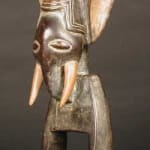Kulango Wooden Heddle Pulley, 20th Century CE
Wood
3.25 x 9.75
PF.5942
Further images
'Nobody likes to live without beautiful things,' replied a Guro weaver when asked why he hung a decoratively carved pulley on his wooden post loom set up beneath a mango...
"Nobody likes to live without beautiful things," replied a Guro weaver when asked why he hung a decoratively carved pulley on his wooden post loom set up beneath a mango tree. The decorative features of West African heddle pulleys -- devices that hold the heddles in looms -- are created solely for aesthetic satisfaction, and have no ritual or magical purpose. The delicately carved figure on the pulley peers down at the weaver as he works and becomes his constant visual companion. The formal composition of these small pieces shows great virtuosity and variation: the artists strive for originality, ingenuity, elegance, and imaginative effects.
Naturalistic faces occur rarely on pulleys. Artists draw upon a wide repertoire of facial styles that are drawn from statues and masks or look to the natural world for inspiration. This heddle pulley takes on the form of an elephant complete with curved trunk, tusks, and exaggerated round ears. The elephant is a tribal symbol of might and strength as well as an international symbol for the greater African continent. White highlights emphasize the tusks and inner ears of this majestic creature in addition to its eyes and the folds of its elongated head. Overall, this charming sculpture is a perfect example of the delicacy, smoothness of finish, and skillful composition that are prized by African carvers.
Naturalistic faces occur rarely on pulleys. Artists draw upon a wide repertoire of facial styles that are drawn from statues and masks or look to the natural world for inspiration. This heddle pulley takes on the form of an elephant complete with curved trunk, tusks, and exaggerated round ears. The elephant is a tribal symbol of might and strength as well as an international symbol for the greater African continent. White highlights emphasize the tusks and inner ears of this majestic creature in addition to its eyes and the folds of its elongated head. Overall, this charming sculpture is a perfect example of the delicacy, smoothness of finish, and skillful composition that are prized by African carvers.









